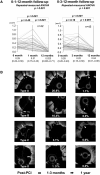Incidence and natural history of coronary evagination after implanted biodegradable polymer sirolimus-eluting stent
- PMID: 35919655
- PMCID: PMC9242038
- DOI: 10.1093/ehjopen/oeac005
Incidence and natural history of coronary evagination after implanted biodegradable polymer sirolimus-eluting stent
Erratum in
-
Corrigendum to articles in EHJ Open missing data availability statements.Eur Heart J Open. 2024 Jan 16;4(1):oead137. doi: 10.1093/ehjopen/oead137. eCollection 2024 Jan. Eur Heart J Open. 2024. PMID: 38230360 Free PMC article.
Abstract
Aims: The incidence and temporal change in coronary evagination (CE) after first-generation drug-eluting stent implantation is well established, whereas that after biodegradable polymer sirolimus-eluting stent (BP-SES) implantation has not yet been evaluated. The aim of this study is to assess the incidence and natural history of CE after BP-SES implantation.
Methods and results: In this multicenter registry, stable coronary lesions treated by Ultimaster BP-SES were evaluated by serial optical frequency domain imaging (OFDI) (at 0-1-12 or 0-3-12 months) and the incidence of CE was assessed. Coronary evagination was defined as the presence of an outward bulge in luminal vessel contour between apposed struts according to the following criteria: (i) evagination depth ≥10% of nominal stent diameter and (ii) evagination length ≥3.0 mm. Optical frequency domain imaging was obtained in 98, 47, 49, and 87 lesions at 0, 1, 3, and 12 months, respectively. Coronary evagination was observed in 20 (42.6%) and 12 (24.5%) lesions at 1 and 3 months, respectively, and all but one CE had resolved at 12 months. At 12 months, the mean CE area was almost zero and the mean malapposed stent area was also decreased. Comparison of the serial OFDI images indicated that CEs originated mostly from acute stent malapposition or coronary dissection behind the implanted stent.
Conclusions: In stable lesions, CE was occasionally observed with Ultimaster BP-SES at 1-3 months but mostly resolved within 12 months, without late-acquired stent malapposition. These findings suggest the safety and feasibility of biodegradable polymer coating on DES.
Keywords: Biodegradable polymer; Chronic coronary syndrome; Drug-eluting stent; Optical frequency domain imaging; Percutaneous coronary intervention.
© The Author(s) 2022. Published by Oxford University Press on behalf of the European Society of Cardiology.
Figures



References
-
- Souteyrand G, Amabile N, Mangin L, Chabin X, Meneveau N, Cayla G, Vanzetto G, Barnay P, Trouillet C, Rioufol G, Range G, Teiger E, Delaunay R, Dubreuil O, Lhermusier T, Mulliez A, Levesque S, Belle L, Caussin C, Motreff P; PESTO Investigators. Mechanisms of stent thrombosis analysed by optical coherence tomography: insights from the national PESTO French registry. Eur Heart J 2016;37:1208–1216. - PubMed
-
- Saito S, Valdes-Chavarri M, Richardt G, Moreno R, Iniguez Romo A, Barbato E, Carrie D, Ando K, Merkely B, Kornowski R, Eltchaninoff H, James S, Wijns W; on behalf of CENTURY II Investigators. A randomized, prospective, intercontinental evaluation of a bioresorbable polymer sirolimus-eluting coronary stent system: the CENTURY II (Clinical Evaluation of New Terumo Drug-Eluting Coronary Stent System in the Treatment of Patients with Coronary Artery Disease) trial. Eur Heart J 2014;35:2021–2031. - PMC - PubMed
-
- Itoh T, Otake H, Kimura T, Tsukiyama Y, Kikuchi T, Okubo M, Hayashi T, Okamura T, Kuramitsu S, Morita T, Sonoda S, Ishihara S, Kuriyama N, Isshiki T, Soeda T, Hibi K, Shinke T, Morino Y; MECHANISM-ULTIMASTER Study Group. A serial optical frequency-domain imaging study of early and late vascular responses to bioresorbable-polymer sirolimus-eluting stents for the treatment of acute myocardial infarction and stable coronary artery disease patients: results of the MECHANISM-ULTIMASTER study. Cardiovasc Interv Ther 2021; doi: 10.1007/s12928-021-00777-4. - PMC - PubMed
-
- Radu MD, Raber L, Kalesan B, Muramatsu T, Kelbaek H, Heo J, Jorgensen E, Helqvist S, Farooq V, Brugaletta S, Garcia-Garcia HM, Juni P, Saunamaki K, Windecker S, Serruys PW. Coronary evaginations are associated with positive vessel remodelling and are nearly absent following implantation of newer-generation drug-eluting stents: an optical coherence tomography and intravascular ultrasound study. Eur Heart J 2014;35:795–807. - PubMed
-
- Virmani R, Guagliumi G, Farb A, Musumeci G, Grieco N, Motta T, Mihalcsik L, Tespili M, Valsecchi O, Kolodgie FD. Localized hypersensitivity and late coronary thrombosis secondary to a sirolimus-eluting stent: should we be cautious? Circulation 2004;109:701–705. - PubMed
LinkOut - more resources
Full Text Sources

